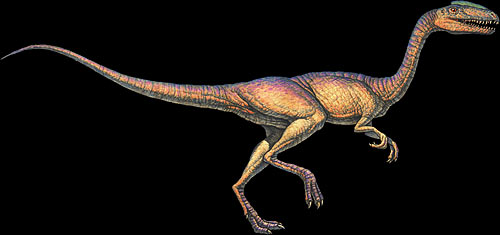@WFS,World Fossil Society,Riffin T Sajeev,Russel T Sajeev
ANATOMY
Syntarsus was a small, lightly-built dinosaur that walked on two long legs. This predator was about 10 feet long (3 m) and weighed about 60-70 pounds. It had light, hollow bones, a long, pointed head with dozens of small, serrated teeth, and a long neck. Syntarsus had large, four-fingered hands with sharp claws. Syntarsus had four-toed feet with fused ankle bones (these ankle bones were like those of early ornithopods although it was an early saurischian dinosaur – these ankle bones were what Syntarsus was named for).
In a bonebed in Zimbabwe, Africa, about 30 fossils were found together. Two types of Syntarsus were found; the more abundant type was about 15% bigger than the less abundant types. Paleontologists, citing examples of modern-day predatory birds, think that the larger, more numerous fossils were females; the smaller, less numerous fossils were males.
Syntarsus kayentakatae, the first Syntarsus found in North America, had double crests; the species found in Africa had no crest.
CLASSIFICATION
Syntarsus (pronounced sin-TAR-sus) was a saurischian (“lizard-hipped”) dinosaur, and a theropod. It was a ceratosaurian and a podokesaur. The type species is S. rhodesiensis. Syntarsus is closely related to Rioarribasaurus and Coelophysis.
WHEN SYNTARSUS LIVED, CLIMATE
Syntarsus lived during the early Jurassic period, about 208 million-194 million years ago. It lived in what was then a seasonally dry, desert-like environment – a Savanna-type climate perhaps like modern-day Kenya but without the grasses (grasses and other flowering plants hadn’t evolved yet).
DIET
Syntarsus was a carnivore, a meat eater. It may also have been a scavenger. Fossilized stomach contents have been found, containing small vertebrates.
BEHAVIOR
Syntarsus probably lived and hunted in packs; this is suggested by the existence of a fossil bonebed (a collections of many fossils of one location) of about 30 Syntarsus found in Zimbabwe, Africa.
LOCOMOTION
Slightly built, long legged, and very light because of its hollow bones, Syntarsus was a very fast, bipedal runner. Dinosaur speeds are estimated using their morphology (characteristics like leg length and estimated body mass) and fossilized trackways. Syntarsus’ footprint is about 4 inches long and the stride length is roughly 2.5 ft (0.75 m).
DISCOVERY OF FOSSILS
Many Syntarsus fossils have found in Zimbabwe, in Africa and Arizona, USA. About 30 Syntarsus fossils were found in a single bonebed in Zimbabwe, suggesting that these predators lived in packs. Along with the Syntarsus fossils was a Massospondylus, a plant-eating prosauropod dinosaur.
Syntarsus was named in 1969 by paleontologist M. A. Raath.
@WFS,World Fossil Society,Riffin T Sajeev,Russel T Sajeev



 February 19th, 2017
February 19th, 2017  Riffin
Riffin 
 Posted in
Posted in  Tags:
Tags: 